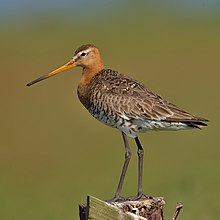
Back Swartstertgriet Afrikaans Limosa limosa AN بقويقة سلطانية سوداء الذيل Arabic بقويقه سلطانيه سوداء الذيل ARZ Limosa limosa AST Böyük oxcüllüt Azerbaijani Ҡыҙғатау Bashkir Black-tailed godwit BCL Грыцук вялікі Byelorussian Вялікі грыцук BE-X-OLD
| Black-tailed godwit | |
|---|---|

| |
| Breeding plumage | |
| Scientific classification | |
| Domain: | Eukaryota |
| Kingdom: | Animalia |
| Phylum: | Chordata |
| Class: | Aves |
| Order: | Charadriiformes |
| Family: | Scolopacidae |
| Genus: | Limosa |
| Species: | L. limosa
|
| Binomial name | |
| Limosa limosa | |
| Subspecies | |

| |
| Range of L. limosa Breeding range Resident range Wintering range
| |
| Synonyms | |
| |
The black-tailed godwit (Limosa limosa) is a large, long-legged, long-billed shorebird first described by Carl Linnaeus in 1758. It is a member of the godwit genus, Limosa. There are four subspecies, all with orange head, neck and chest in breeding plumage and dull grey-brown winter coloration, and distinctive black and white wingbar at all times.
Its breeding range stretches from Iceland through Europe and areas of central Asia. Black-tailed godwits spend (the northern hemisphere) winter in areas as diverse as the Indian subcontinent, Australia, New Zealand, western Europe and west Africa. The species breeds in fens, lake edges, damp meadows, moorlands and bogs and uses estuaries, swamps and floods in (the northern hemisphere) winter; it is more likely to be found inland and on freshwater than the similar bar-tailed godwit. The world population is estimated to be 634,000 to 805,000 birds and is classified as Near Threatened. The black-tailed godwit is the national bird of the Netherlands.
- ^ BirdLife International (2017) [amended version of 2016 assessment]. "Limosa limosa". IUCN Red List of Threatened Species. 2017: e.T22693150A111611637. doi:10.2305/IUCN.UK.2017-1.RLTS.T22693150A111611637.en.
- ^ "Limosa belgica". gbif.org. Retrieved 4 November 2021.
